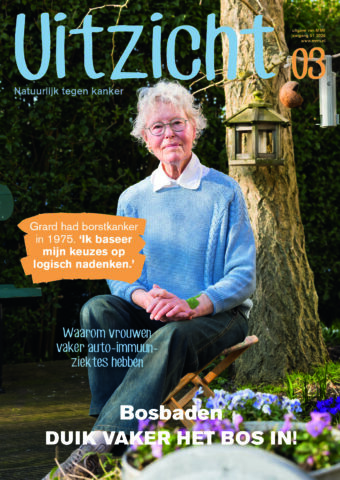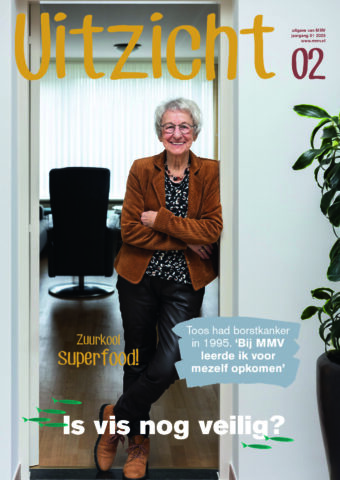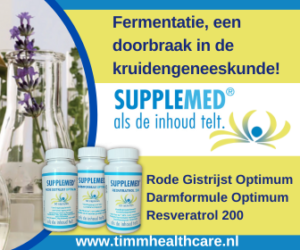Moeheid en kortademigheid kenmerken long-COVID. De moeheid heeft opvallend veel overeenkomsten met het chronische vermoeidheidssyndroom (ME/CVS).

Wereldwijd waren er tot eind vorig jaar 237 miljoen COVID-19 gevallen waarvan er 4,8 miljoen overleden (1,8 procent). Er waren 100 miljoen gevallen die last hadden van post-acute gevolgen (2,4 procent) (1).
De meest voorkomende symptomen waren kortademigheid en vermoeidheid (1a), maar ook malaise na inspanning en/of slecht uithoudingsvermogen, cognitieve achteruitgang, concentratieproblemen en vergeetachtigheid (‘hersenmist’). Verder: pijn in de spieren, gewrichten, hoofd en borst, slapeloosheid, hoesten, diarree, haarverlies, hartkloppingen, angst/depressie en verlies van reuk en smaak (2-10). Een eenduidige definitie van long-COVID bestaat nog niet, maar er is intussen een lijst van 205 symptomen opgesteld (2,11).
Tot nader order definieert het Amerikaanse ‘Centers of Disease Control and Prevention’ (CDC) long-COVID als een ‘reeks nieuwe, terugkerende of aanhoudende gezondheidsproblemen vier of meer weken na een SARS-CoV-2-infectie’. Na de acute fase is er geen terugkeer naar het gebruikelijke gezondheidsniveau (4).
Long-COVID geeft klachten afkomstig van meerdere organen (2-4) en verlaagt de kwaliteit van leven (3). Opvallend is dat veel symptomen overeenkomen met die van ME/CVS. Een verschil is de kortademigheid bij long-COVID. Die ontstaat door schade aan longen en hart door SARS-CoV-2 en het immuunsysteem (3,12,13,21). ME/CVS ontstaat vaak na (herhaalde) virus of bacteriële infecties (13-19), waaronder die met het beruchte Epstein-Barr-Virus (20,21). Negentig procent van de bevolking is drager daarvan (21). Clusteruitbraken van ME/CVS in ziekenhuizen, scholen, verpleegstershuizen en onder soldaten en orkestleden (22,23) wijzen op een besmettelijke achtergrond.
Hoe ontstaat de vermoeidheid bij ME/CVS? Dat heeft te maken met een gestoorde energiestofwisseling. Bij ME/CVS is het opwekken van energie (ATP) in de mitochondriën beperkt (24-26). Iets soortgelijks is waarschijnlijk ook bij long-COVID aan de hand (14). In lichaamscellen van patiënten met ME/CVS geeft glucose de voorkeur aan een ‘metabole’ route die veel minder energie oplevert: 2 ATP versus 36 ATP. Gewoonlijk doen cellen dit bij zuurstoftekort, maar dat is hier niet aan de hand.
Wat gebeurt er dan wel? Virussen en bacteriën die in cellen groeien parasiteren op de nutriënten van de gastheercel (27-31). Het lijkt er steeds meer op dat de chronische vermoeidheid (deels) wordt veroorzaakt door hardnekkige microben die het metabolisme kapen. Ze her-programmeren de stofwisseling dusdanig dat de cel de bouwstenen maakt voor hun onderhoud en vermenigvuldiging (27). De daarvoor benodigde energie wordt ook onttrokken aan de gastheercel.
Voor sommigen bleek COVID-19 een nucleaire bom voor het immuunsysteem (2) met lange-termijn gevolgen voor de gezondheid. Maar ook voor het gezondheidszorgsysteem, de economische productiviteit en onze gemiddelde levensverwachting (32-33). Ook jongeren worden niet gespaard. Tien procent van de PCR-positieve kinderen van 2-11 jaar had na vijf weken nog symptomen (2) en 25 procent van de gehospitaliseerde 3-15 jarige kinderen met acute COVID-19 had maanden daarna nog last van vermoeidheid, slaapstoornissen en zintuigelijke problemen (34).
Met onderzoek van long-COVID komt wellicht ook een betere therapie voor ME/CVS in beeld. Lang is onterecht gedacht dat ME/CVS patiënten baat hebben bij graduele oefening en cognitieve gedragstherapie. Lichte oefening lukt zelfs gemotiveerde ME/CVS patiënten vaak niet (14,35-37). Wie wat begrijpt van energie-metabolisme had dat kunnen voorspellen. Het is een wrange constatering dat vanwege long-COVID, ME/CVS nu eindelijk serieuzer lijkt te worden genomen (14,38-40).
Beeld: Pixabay
1. Steward C. Long COVID in the United Kingdom (UK) – statistics & facts Published by Conor Stewart,Feb 15, 2022. accessed 24 02 2022
https://www.statista.com/topics/8340/long-covid-in-the-uk/#dossierKeyfigures
1a. Chen C et al. Global Prevalence of Post-Acute Sequelae of COVID-19 (PASC) or Long COVID: A Meta-Analysis and Systematic Review. medRxiv Posted November 16, 2021. doi: https://doi.org/10.1101/2021.11.15.21266377
https://www.medrxiv.org/content/10.1101/2021.11.15.21266377v1
2. Marshall M. The four most urgent questions about long COVID. Nature. 2021 Jun;594(7862):168-170. doi: 10.1038/d41586-021-01511-z. PMID: 34108700.
https://pubmed.ncbi.nlm.nih.gov/34108700/
3. Nalbandian A, Sehgal K, Gupta A, Madhavan MV, McGroder C, Stevens JS, Cook JR, Nordvig AS, Shalev D, Sehrawat TS, Ahluwalia N, Bikdeli B, Dietz D, Der-Nigoghossian C, Liyanage-Don N, Rosner GF, Bernstein EJ, Mohan S, Beckley AA, Seres DS, Choueiri TK, Uriel N, Ausiello JC, Accili D, Freedberg DE, Baldwin M, Schwartz A, Brodie D, Garcia CK, Elkind MSV, Connors JM, Bilezikian JP, Landry DW, Wan EY. Post-acute COVID-19 syndrome. Nat Med. 2021 Apr;27(4):601-615. doi: 10.1038/s41591-021-01283-z. Epub 2021 Mar 22. PMID: 33753937.
https://pubmed.ncbi.nlm.nih.gov/33753937/
4. Centers for Disease Control and Prevention (CDC). Post-COVID: Information for Healthcare Providers, Updated July 9, 2021. Accessed 24 02 2022.
https://www.cdc.gov/coronavirus/2019-ncov/hcp/clinical-care/post-covid-conditions.html
5. Proal AD, VanElzakker MB. Long COVID or Post-acute Sequelae of COVID-19 (PASC): An Overview of Biological Factors That May Contribute to Persistent Symptoms. Front Microbiol. 2021 Jun 23;12:698169. doi: 10.3389/fmicb.2021.698169. PMID: 34248921; PMCID: PMC8260991.
https://pubmed.ncbi.nlm.nih.gov/34248921/
6. Chippa V, Aleem A, Anjum F. Post Acute Coronavirus (COVID-19) Syndrome. 2022 Feb 6. In: StatPearls [Internet]. Treasure Island (FL): StatPearls Publishing; 2022 Jan–. PMID: 34033370.
https://pubmed.ncbi.nlm.nih.gov/34033370/
7. Gebhard CE et al. Sex- and Gender-specific Risk Factors of Post-COVID-19 Syndrome: A Population-based Cohort Study in Switzerland. MedRxiv 6 july 2021
https://www.medrxiv.org/content/10.1101/2021.06.30.21259757v1
8. Davis HE, Assaf GS, McCorkell L, Wei H, Low RJ, Re’em Y, Redfield S, Austin JP, Akrami A. Characterizing long COVID in an international cohort: 7 months of symptoms and their impact. EClinicalMedicine. 2021 Aug;38:101019. doi: 10.1016/j.eclinm.2021.101019. Epub 2021 Jul 15. PMID: 34308300; PMCID: PMC8280690.
https://pubmed.ncbi.nlm.nih.gov/34308300/
9. Su Y et al. Multiple Early Factors Anticipate Post-Acute COVID-19 Sequelae. Cell 2022 in press. ISSN: 0092-8674, https://doi.org/10.1016/j.cell.2022.01.014
https://plu.mx/plum/a/?doi=10.1016/j.cell.2022.01.014
10. RIVM. Zorggebruik neemt toe bij langdurige COVID-19 klachten Publicatiedatum 29-11-2021 | 10:00. Accessed 24 02 2022.
https://www.rivm.nl/nieuws/zorggebruik-neemt-toe-bij-langdurige-covid-19-klachten
11. Lopez-Leon S et al. More than 50 Long-term effects of COVID-19: a systematic review and meta-analysis. medRxiv [Preprint]. 2021
https://www.medrxiv.org/content/10.1101/2021.01.27.21250617v2
12. Garg M, Maralakunte M, Garg S, Dhooria S, Sehgal I, Bhalla AS, Vijayvergiya R, Grover S, Bhatia V, Jagia P, Bhalla A, Suri V, Goyal M, Agarwal R, Puri GD, Sandhu MS. The Conundrum of ‘Long-COVID-19’: A Narrative Review. Int J Gen Med. 2021 Jun 14;14:2491-2506. doi: 10.2147/IJGM.S316708. PMID: 34163217; PMCID: PMC8214209.
https://pubmed.ncbi.nlm.nih.gov/34163217/
13. Sukocheva OA et al. Analysis of post COVID-19 condition and its overlap with myalgic encephalomyelitis/chronic fatigue syndrome. Journal of Advanced Research Available online 26 November 2021, in press
https://www.sciencedirect.com/science/article/pii/S2090123221002320
14. Bateman L, Bested AC, Bonilla HF, Chheda BV, Chu L, Curtin JM, Dempsey TT, Dimmock ME, Dowell TG, Felsenstein D, Kaufman DL, Klimas NG, Komaroff AL, Lapp CW, Levine SM, Montoya JG, Natelson BH, Peterson DL, Podell RN, Rey IR, Ruhoy IS, Vera-Nunez MA, Yellman BP. Myalgic Encephalomyelitis/Chronic Fatigue Syndrome: Essentials of Diagnosis and Management. Mayo Clin Proc. 2021 Nov;96(11):2861-2878. doi: 10.1016/j.mayocp.2021.07.004. Epub 2021 Aug 25. PMID: 34454716.
https://pubmed.ncbi.nlm.nih.gov/34454716/
15. Committee on the Diagnostic Criteria for Myalgic Encephalomyelitis/Chronic Fatigue Syndrome; Board on the Health of Select Populations; Institute of Medicine. Beyond Myalgic Encephalomyelitis/Chronic Fatigue Syndrome: Redefining an Illness. Washington (DC): National Academies Press (US); 2015 Feb 10. PMID: 25695122.
https://pubmed.ncbi.nlm.nih.gov/25695122/
16. Crisy C. Chronic Fatigue May Be Long-Term Effect of COVID. WebMed August 10, 2020
https://www.webmd.com/lung/news/20200809/chronic-fatigue-may-be-long-term-effect-of-covid
17. Kedor C et al. Chronic COVID-19 Syndrome and Chronic Fatigue Syndrome (ME/CFS) following the first pandemic wave in Germany – a first analysis of a prospective observational study. Medrxiv. Posted February 08, 2021.
https://www.medrxiv.org/content/10.1101/2021.02.06.21249256v1
18. Wong TL, Weitzer DJ. Long COVID and Myalgic Encephalomyelitis/Chronic Fatigue Syndrome (ME/CFS)-A Systemic Review and Comparison of Clinical Presentation and Symptomatology. Medicina (Kaunas). 2021 Apr 26;57(5):418. doi: 10.3390/medicina57050418. PMID: 33925784; PMCID: PMC8145228.
https://pubmed.ncbi.nlm.nih.gov/33925784/
19. Komaroff AL, Lipkin WI. Insights from myalgic encephalomyelitis/chronic fatigue syndrome may help unravel the pathogenesis of postacute COVID-19 syndrome. Trends Mol Med. 2021 Sep;27(9):895-906. doi: 10.1016/j.molmed.2021.06.002. Epub 2021 Jun 7. PMID: 34175230; PMCID: PMC8180841.
https://pubmed.ncbi.nlm.nih.gov/34175230/
20. Pedersen M, Asprusten TT, Godang K, Leegaard TM, Osnes LT, Skovlund E, Tjade T, Øie MG, Wyller VBB. Predictors of chronic fatigue in adolescents six months after acute Epstein-Barr virus infection: A prospective cohort study. Brain Behav Immun. 2019 Jan;75:94-100. doi: 10.1016/j.bbi.2018.09.023. Epub 2018 Sep 25. PMID: 30261303.
https://pubmed.ncbi.nlm.nih.gov/30261303/
21. Ruiz-Pablos M, Paiva B, Montero-Mateo R, Garcia N, Zabaleta A. Epstein-Barr Virus and the Origin of Myalgic Encephalomyelitis or Chronic Fatigue Syndrome. Front Immunol. 2021 Nov 15;12:656797. doi: 10.3389/fimmu.2021.656797. PMID: 34867935; PMCID: PMC8634673.
https://pubmed.ncbi.nlm.nih.gov/34867935/
22. Myalgic encephalomyelitis. INFORMATION ABOUT ME AND CFS FROM PARADIGM CHANGE Cluster Outbreaks
23. Wikipedia. List of myalgic encephalomyelitis and chronic fatigue syndrome outbreaks
https://me-pedia.org/wiki/List_of_myalgic_encephalomyelitis_and_chronic_fatigue_syndrome_outbreaks
24. Fluge Ø, Mella O, Bruland O, Risa K, Dyrstad SE, Alme K, Rekeland IG, Sapkota D, Røsland GV, Fosså A, Ktoridou-Valen I, Lunde S, Sørland K, Lien K, Herder I, Thürmer H, Gotaas ME, Baranowska KA, Bohnen LM, Schäfer C, McCann A, Sommerfelt K, Helgeland L, Ueland PM, Dahl O, Tronstad KJ. Metabolic profiling indicates impaired pyruvate dehydrogenase function in myalgic encephalopathy/chronic fatigue syndrome. JCI Insight. 2016 Dec 22;1(21):e89376. doi: 10.1172/jci.insight.89376. PMID: 28018972; PMCID: PMC5161229.
https://pubmed.ncbi.nlm.nih.gov/28018972/
25. Naviaux RK, Naviaux JC, Li K, Bright AT, Alaynick WA, Wang L, Baxter A, Nathan N, Anderson W, Gordon E. Metabolic features of chronic fatigue syndrome. Proc Natl Acad Sci U S A. 2016 Sep 13;113(37):E5472-80. doi: 10.1073/pnas.1607571113. Epub 2016 Aug 29. Erratum in: Proc Natl Acad Sci U S A. 2017 May 2;114(18):E3749. PMID: 27573827; PMCID: PMC5027464.
https://pubmed.ncbi.nlm.nih.gov/27573827/
26. Abdel-Haleem AM, Lewis NE, Jamshidi N, Mineta K, Gao X, Gojobori T. The Emerging Facets of Non-Cancerous Warburg Effect. Front Endocrinol (Lausanne). 2017 Oct 23;8:279. doi: 10.3389/fendo.2017.00279. PMID: 29109698; PMCID: PMC5660072.
https://pubmed.ncbi.nlm.nih.gov/29109698/
27. Eisenreich W, Rudel T, Heesemann J, Goebel W. How Viral and Intracellular Bacterial Pathogens Reprogram the Metabolism of Host Cells to Allow Their Intracellular Replication. Front Cell Infect Microbiol. 2019 Mar 4;9:42. doi: 10.3389/fcimb.2019.00042. PMID: 30886834; PMCID: PMC6409310.
https://pubmed.ncbi.nlm.nih.gov/30886834/
28. Abu Kwaik Y, Bumann D. Microbial quest for food in vivo: ‘nutritional virulence’ as an emerging paradigm. Cell Microbiol. 2013 Jun;15(6):882-90. doi: 10.1111/cmi.12138. Epub 2013 Apr 3. PMID: 23490329.
https://pubmed.ncbi.nlm.nih.gov/23490329/
29. Abu Kwaik Y, Bumann D. Host Delivery of Favorite Meals for Intracellular Pathogens. PLoS Pathog. 2015 Jun 25;11(6):e1004866. doi: 10.1371/journal.ppat.1004866. PMID: 26110434; PMCID: PMC4482385.
https://pubmed.ncbi.nlm.nih.gov/26110434/
30. Best A, Abu Kwaik Y. Nutrition and Bipartite Metabolism of Intracellular Pathogens. Trends Microbiol. 2019 Jun;27(6):550-561. doi: 10.1016/j.tim.2018.12.012. Epub 2019 Jan 14. PMID: 30655036; PMCID: PMC6527459.
https://pubmed.ncbi.nlm.nih.gov/30655036/
31. Casadevall A, Fang FC. The intracellular pathogen concept. Mol Microbiol. 2020 Mar;113(3):541-545. doi: 10.1111/mmi.14421. Epub 2019 Nov 25. PMID: 31762116.
https://pubmed.ncbi.nlm.nih.gov/31762116/
32. Paul BD, Lemle MD, Komaroff AL, Snyder SH. Redox imbalance links COVID-19 and myalgic encephalomyelitis/chronic fatigue syndrome. Proc Natl Acad Sci U S A. 2021 Aug 24;118(34):e2024358118. doi: 10.1073/pnas.2024358118. PMID: 34400495; PMCID: PMC8403932.
https://pubmed.ncbi.nlm.nih.gov/34400495/
33. Tanne JH. Covid-19: Even mild infections can cause long term heart problems, large study finds. BMJ. 2022 Feb 14;376:o378. doi: 10.1136/bmj.o378. PMID: 35165093.
https://pubmed.ncbi.nlm.nih.gov/35165093/
34. Osmanov IM, Spiridonova E, Bobkova P, Gamirova A, Shikhaleva A, Andreeva M, Blyuss O, El-Taravi Y, DunnGalvin A, Comberiati P, Peroni DG, Apfelbacher C, Genuneit J, Mazankova L, Miroshina A, Chistyakova E, Samitova E, Borzakova S, Bondarenko E, Korsunskiy AA, Konova I, Hanson SW, Carson G, Sigfrid L, Scott JT, Greenhawt M, Whittaker EA, Garralda E, Swann OV, Buonsenso D, Nicholls DE, Simpson F, Jones C, Semple MG, Warner JO, Vos T, Olliaro P, Munblit D; and the Sechenov StopCOVID Research Team. Risk factors for post-COVID-19 condition in previously hospitalised children using the ISARIC Global follow-up protocol: a prospective cohort study. Eur Respir J. 2022 Feb 3;59(2):2101341. doi: 10.1183/13993003.01341-2021. PMID: 34210789; PMCID: PMC8576804.
https://pubmed.ncbi.nlm.nih.gov/34210789/
35. Friedberg F, Sunnquist M, Nacul L. Rethinking the Standard of Care for Myalgic Encephalomyelitis/Chronic Fatigue Syndrome. J Gen Intern Med. 2020 Mar;35(3):906-909. doi: 10.1007/s11606-019-05375-y. Epub 2019 Oct 21. PMID: 31637650; PMCID: PMC7080939.
https://pubmed.ncbi.nlm.nih.gov/31637650/
36. National Institute for Health and Care Excellence (NICE). Myalgic encephalomyelitis (or encephalopathy)/chronic fatigue syndrome: diagnosis and management. NICE guideline [NG206]Published: 29 October 2021
https://www.nice.org.uk/guidance/ng206
37. Flottorp SA, Brurberg KG, Fink P, Knoop H, Wyller VBB. New NICE guideline on chronic fatigue syndrome: more ideology than science? Lancet. 2022 Feb 12;399(10325):611-613. doi: 10.1016/S0140-6736(22)00183-0. PMID: 35151381.
https://pubmed.ncbi.nlm.nih.gov/35151381/
38. Institute of Medicine 2015. Beyond Myalgic Encephalomyelitis/Chronic Fatigue Syndrome: Redefining an Illness. Washington, DC: The National Academies Press. https://doi.org/10.17226/19012.
https://www.ncbi.nlm.nih.gov/books/NBK274235/pdf/Bookshelf_NBK274235.pdf
39. Brüssow H, Timmis K. COVID-19: long covid and its societal consequences. Environ Microbiol. 2021 Aug;23(8):4077-4091. doi: 10.1111/1462-2920.15634. Epub 2021 Jun 22. PMID: 34110078.
https://pubmed.ncbi.nlm.nih.gov/34110078/
40. Yong E. Even Health-Care Workers With Long COVID Are Being Dismissed. Accessed 20 02 2022
MMV maakt wekelijks een selectie uit het nieuws over voeding en leefstijl in relatie tot kanker en andere medische condities.
Inschrijven nieuwsbrief








